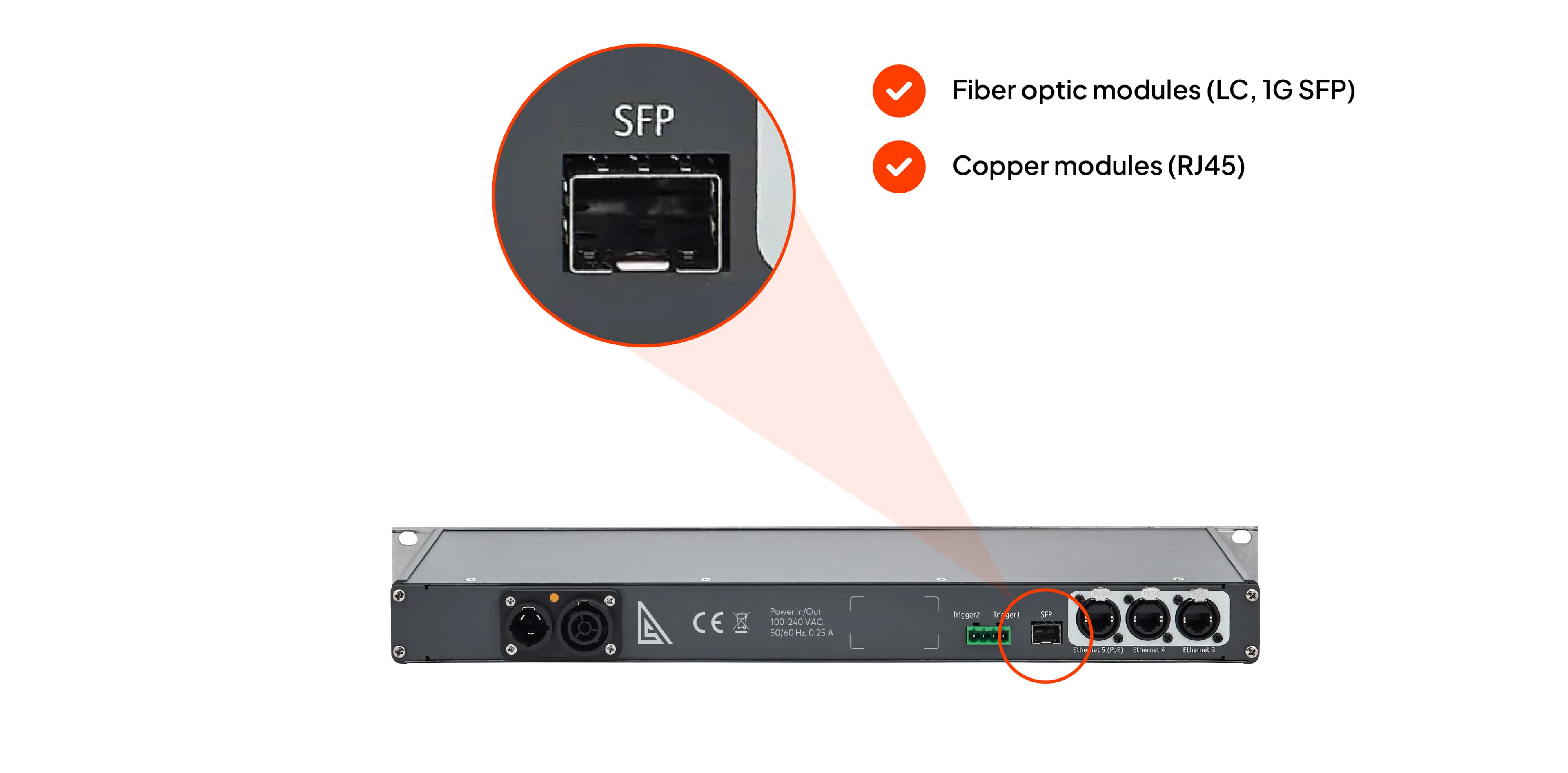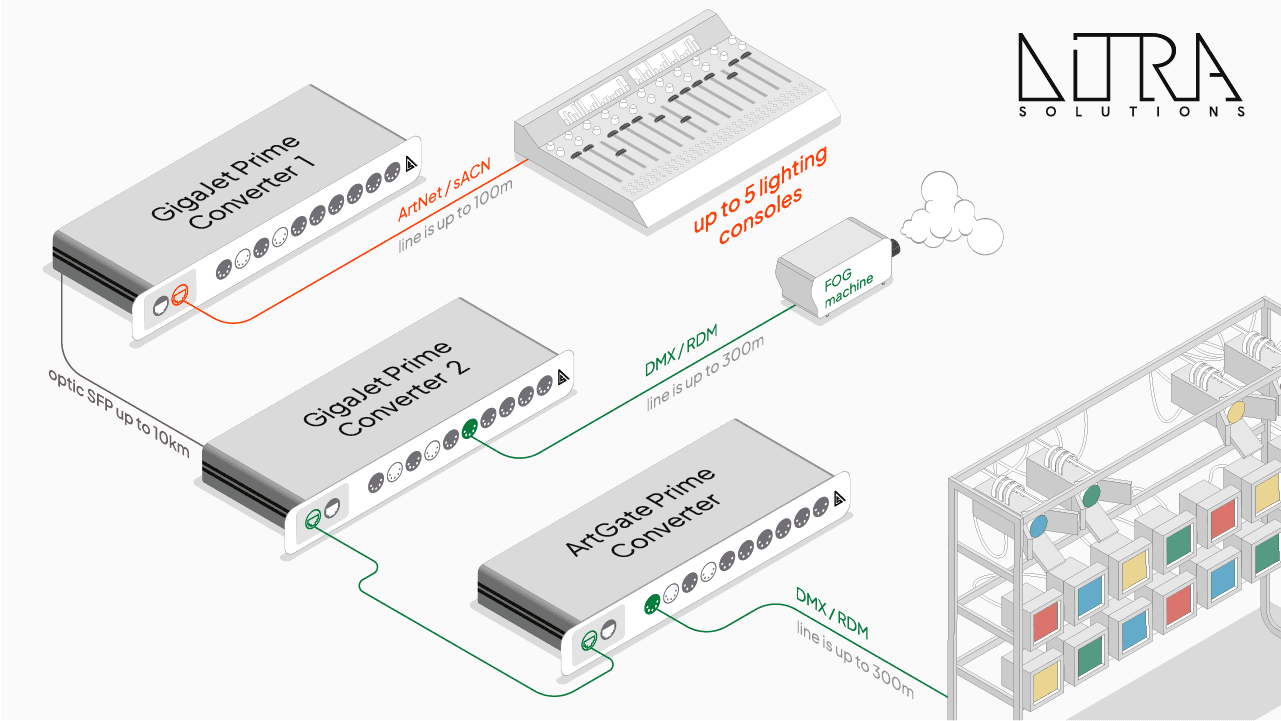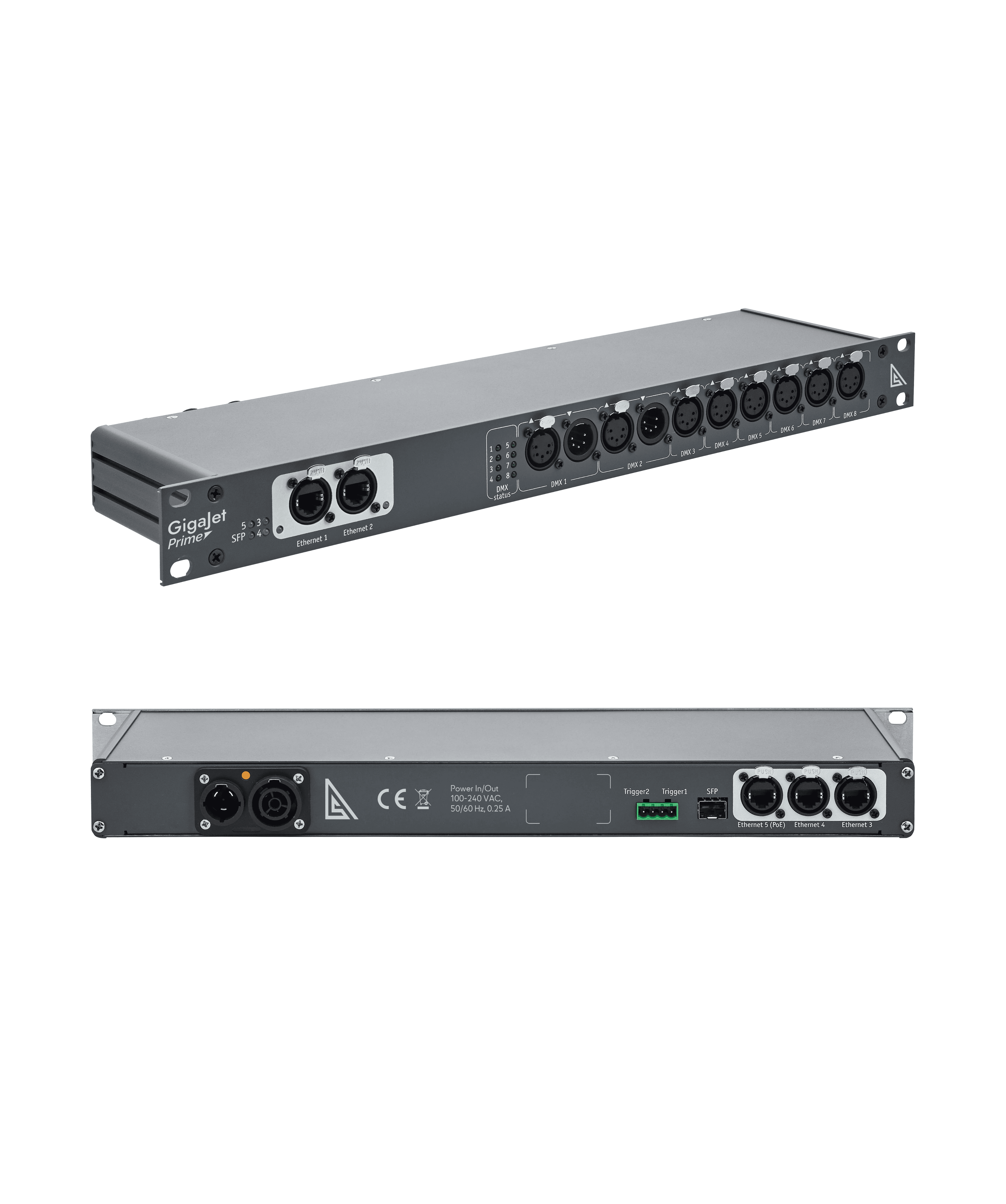DMX transmission over fiber optics: Implementation flexibility via SFP Ports
How fiber optics is reshaping long-distance lighting control

In professional lighting projects — whether concert venues, stadium facade lighting, or distributed architectural installations — there is often a need to transmit control signals over long distances. However, a standard Ethernet cable with an RJ-45 connector (twisted pair) is limited in length: reliable data transmission is only possible up to 100 meters.
This limitation can be overcome in two ways:
- Extension using Ethernet repeaters or switches — but this setup complicates the infrastructure, increases the project cost, and is susceptible to interference, especially in electromagnetically "noisy" environments.
- Transition to fiber optic lines enables data transmission over distances of up to 10 km, ensuring complete interference immunity, high bandwidth, and reliability in large-scale events and distributed systems.
Fiber optic lines in lighting control systems
Fiber optics is used as a transport medium for lighting control network protocols such as Art-Net, sACN, or KiNet, where DMX data is encapsulated into Ethernet packets. This approach enables transmission of thousands of DMX universes through a single physical channel and flexible routing within standard network infrastructure.

Universal SFP ports as a connection architecture option
Traditionally, devices for DMX transmission over fiber optics were equipped with fixed optical interfaces pre-defined by the manufacturer (e.g., SC or ST connectors with integrated transceivers). This approach was reliable but limited flexibility: the type of optical line had to be selected during procurement, and any change in requirements meant replacing the entire device.
An alternative architecture is the use of a universal SFP port. This port can accept both optical modules (LC, multimode and single-mode) and copper modules (RJ45). This allows equipment to be adapted to specific project conditions, reduces the number of model variants, and simplifies replacement or upgrades on site. The following options are commonly used:
- Fiber optic modules (LC, 1G SFP): Multimode (850 nm, OM3/OM4) allow transmission up to 550 m; single-mode (1310/1550 nm, OS2) — up to 10–20 km depending on optics.
- Copper modules (RJ45): Allow use of Cat5e/Cat6 cable up to 100 m and provide compatibility with existing Ethernet infrastructure.

Example of building a fiber optic lighting control system in a concert hall using the GigaJet Prime converter by Ditra Solutions
In concert halls where the FOH (Front of House) technical room is located at a significant distance from the stage, it's important to ensure reliable and interference-free signal transmission. In this example, the lighting control system starts in the FOH area, where several lighting consoles can be connected simultaneously.
Each console generates its own DMX universes and sends data via Ethernet cable using Art-Net or sACN protocols. All signals are sent to the DMX/Ethernet GigaJet Prime converter.
The GigaJet Prime device in rack format (1U) combines the data received from all consoles and sends it over single-mode fiber optics to the stage using the SFP port. A fiber optic line with a range of up to 10 km provides stable signal transmission over long distances, eliminating the limitations typical of copper cables.
At the stage, the second GigaJet Prime unit receives the optical signal via its SFP port and distributes the data to connected equipment. Thanks to eight optically isolated DMX outputs, the signal is sent to various lighting devices:
- Moving heads and dynamic fixtures
- Smoke machines and special effects generators
- Pyrotechnic and laser systems
- Other DMX-compatible devices
In addition, the DMX signal from GigaJet Prime can be routed to other DMX converters via Ethernet protocol, such as ArtGate Prime. This allows for system expansion, connecting additional zones or lighting lines, while maintaining integrity and synchronization of control.
Additionally, the system supports RDM (Remote Device Management), allowing feedback on the status, configuration, and diagnostics of the equipment. This data is returned to the FOH via the same fiber optic line, providing remote monitoring without the need for physical access to stage devices.

Main features of GigaJET Prime
GigaJET Prime is a 1U DMX/Ethernet converter for professional use developed by Ditra Solutions. It includes the following specifications:
- 8 galvanically isolated DMX512 ports, configurable as IN/OUT
- Support for Art-Net I–IV, sACN (draft, release), KiNet v1/v2, RTTrPL, RDM (E1.20) protocols
- Universal SFP port (SFP-RJ45/Fiber) supporting both fiber optic and copper SFP modules
- Built-in 5-port Gigabit Ethernet switch (RJ45 EtherCON), PoE support
- Support for redundant transmission schemes, ring and star topologies (with external managed switches)
- Power supply: 90–315 V AC or PoE (IEEE 802.3af). Maximum consumption — 5 W
- Status indicators for each interface, web configuration interface, support for ArtGate Setting and third-party Art-Net configurators
- Fast recovery after power outage, support for static scenes and profiles
- Form factor: 1U, IP54, passive cooling without fans
DMX transmission over fiber optic lines is a technically justified solution for extended and distributed lighting control systems, where long distances, noise immunity, and scalability are critical.
Depending on the architecture, the project uses Ethernet protocols (Art-Net, sACN, KiNet) in which DMX data is encapsulated in IP traffic. Architecture with a universal SFP interface provides additional flexibility: it allows choosing between multimode or single-mode optics and copper modules (RJ45 or LC/SC/ST) without replacing the equipment. This approach complies with IEEE 802.3 and ANSI ESTA standards and allows designers to adapt the system to site-specific conditions, optimizing the control infrastructure without being tied to a specific physical medium.



